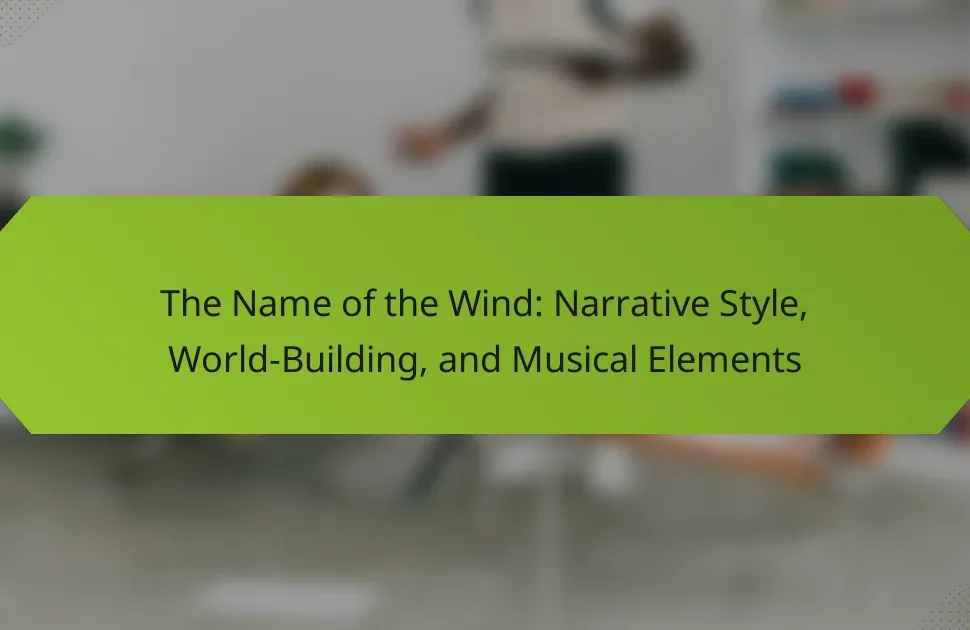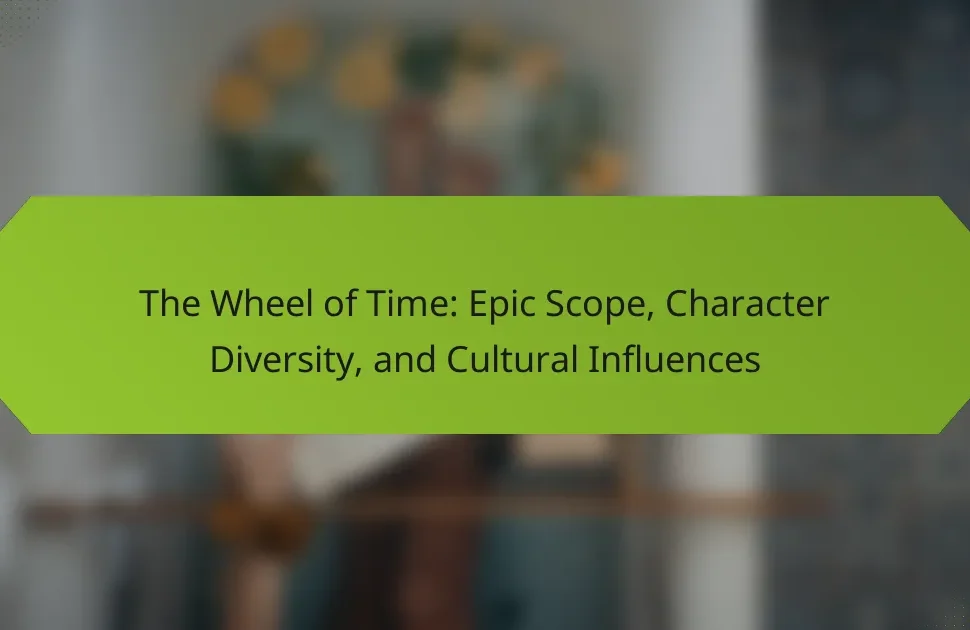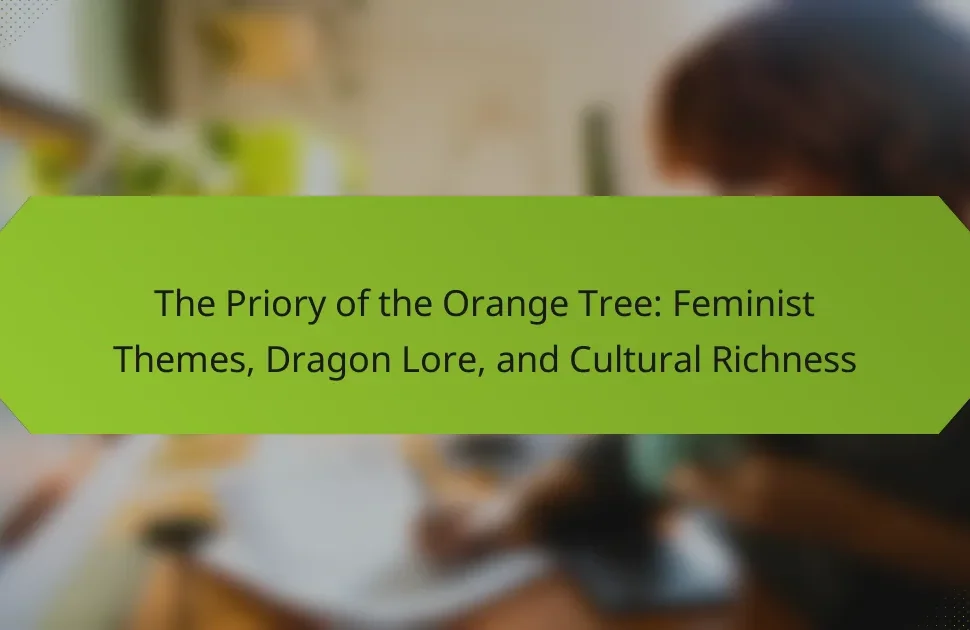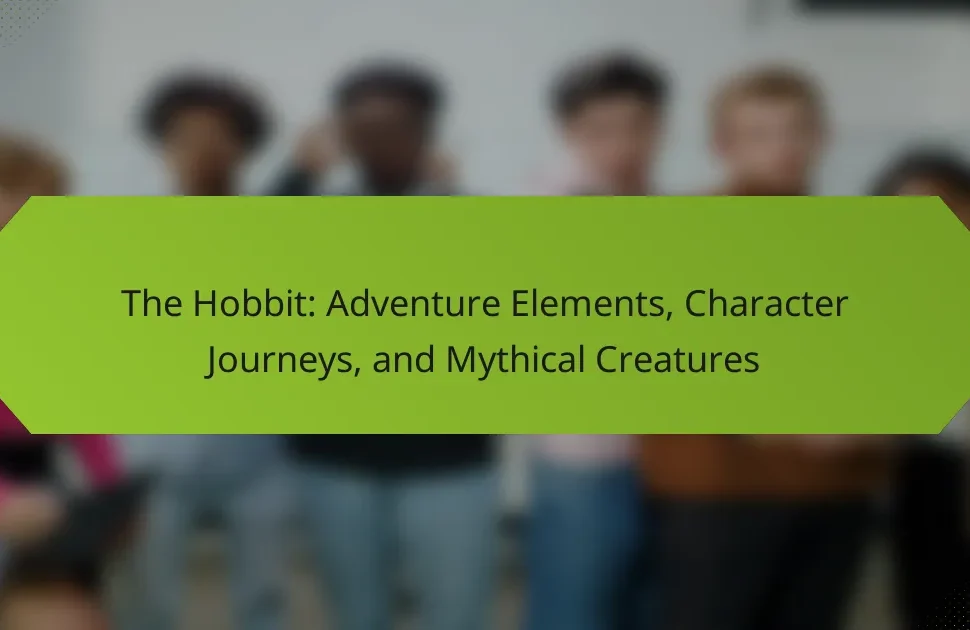The Mistborn series captivates readers through its intricate character development, immersive world-building, and unique magic systems. Characters like Vin and Elend evolve significantly, reflecting their struggles and choices. The detailed setting of Scadrial influences character motivations and interactions, while the magic systems of Allomancy, Feruchemy, and Hemalurgy introduce moral complexities. Together, these elements create a rich narrative that explores themes of power, trust, and societal structures.

How does character development shape the narrative in the Mistborn series?
Character development is crucial in the Mistborn series as it drives the plot and shapes the world. Characters like Vin and Elend undergo significant growth that reflects their struggles and choices. This evolution creates emotional depth, engaging readers and enhancing the narrative. The interplay between character arcs and the magic system adds complexity, as characters’ abilities influence their development and decisions. As a result, character journeys not only propel the story but also enrich the themes of trust, power, and sacrifice.
What are the key character arcs throughout the trilogy?
The Mistborn trilogy features significant character arcs that evolve through personal struggles and transformations. Vin transitions from a street urchin to a powerful Mistborn leader, embracing her identity and responsibilities. Elend Venture evolves from a naive noble into a decisive ruler, grappling with the weight of leadership. Sazed undergoes a profound journey of faith, ultimately finding purpose in the balance of knowledge and belief. These arcs highlight themes of growth, sacrifice, and the complexities of power.
How do relationships between characters evolve over time?
Relationships between characters in the Mistborn series evolve significantly, driven by shared experiences and personal growth. Initially, characters often harbor mistrust and conflicting motivations. As the story unfolds, alliances form, leading to deeper emotional connections. For example, Vin’s relationship with Elend transitions from skepticism to love, reflecting her journey of self-discovery. The impact of the world’s magic system further influences these dynamics, as characters confront challenges that test their bonds. Ultimately, character development and world-building intertwine, showcasing how relationships transform through adversity and shared goals.
In what ways do characters reflect the themes of power and morality?
Characters in the Mistborn series embody the themes of power and morality through their complex motivations and choices. For instance, Vin’s evolution from a street urchin to a powerful Allomancer illustrates the struggle between using power for personal gain versus the greater good. Elend Venture represents the idealistic pursuit of a moral society despite the corrupting influence of power. Kelsier’s rebellious nature showcases the moral ambiguity of fighting oppression, often blurring the lines between heroism and villainy. These characters reflect the intricate balance of power dynamics and ethical dilemmas, emphasizing that morality is often subjective and context-dependent.
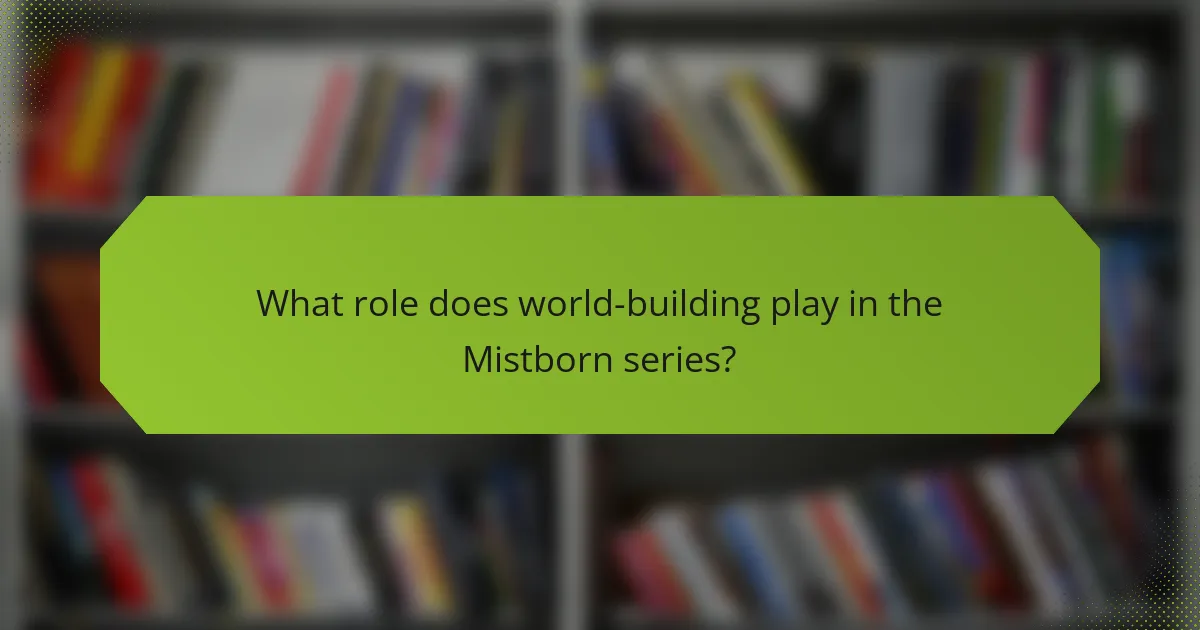
What role does world-building play in the Mistborn series?
World-building is crucial in the Mistborn series as it shapes character motivations and the magic system. The detailed setting of Scadrial, with its unique social structures and environmental elements, influences characters’ development and interactions. The rich lore and history create a backdrop that enhances the narrative, allowing characters to evolve in response to their world. The intricate magic system, based on metals, is deeply integrated into the society, affecting power dynamics and personal growth. This interplay between world-building and character arcs showcases Brandon Sanderson’s skill in crafting a cohesive narrative.
How does the setting influence character choices and plot progression?
The setting significantly influences character choices and plot progression in the Mistborn series. The oppressive world of Scadrial shapes characters’ motivations, forcing them to navigate societal constraints and power dynamics. For example, the harshness of the Final Empire drives characters like Vin to seek freedom and belonging. The unique magic system, Allomancy, interacts with the environment, impacting strategic decisions in conflicts. Additionally, the setting’s historical context enriches character backstories, revealing how past events inform present actions. This interplay between setting and character development propels the narrative forward, creating a compelling and immersive experience.
Which cultural elements are depicted in the world of Scadrial?
The world of Scadrial features diverse cultural elements, including social hierarchy, religious beliefs, and unique customs. The class system is stark, with nobility and skaa representing significant divides. Religion plays a crucial role, with the worship of various deities influencing societal norms. Cultural practices, such as Allomantic traditions, shape interactions and community dynamics. Additionally, the influence of the Lord Ruler creates a distinct cultural identity that persists throughout the series.
How does the history of the world impact the current events in the series?
The history of the world significantly shapes current events in the Mistborn series by influencing character motivations and societal structures. The oppressive regime of the Lord Ruler creates a backdrop of fear and rebellion, driving characters like Vin and Elend to challenge the status quo. Historical events, such as the Ascension and the subsequent collapse of the Final Empire, inform the characters’ understanding of power and justice. This historical context enriches the world-building, making the struggle for freedom and identity resonate deeply. The interplay between past and present highlights how history can dictate the choices and fates of individuals within the narrative.
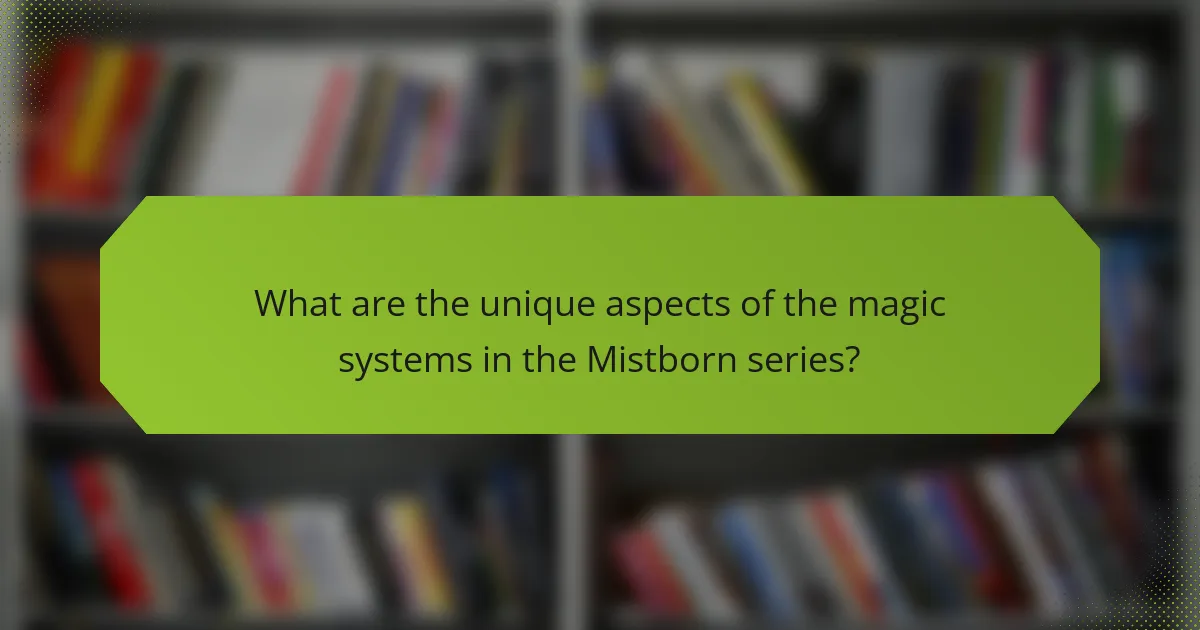
What are the unique aspects of the magic systems in the Mistborn series?
The unique aspects of the magic systems in the Mistborn series include the use of Allomancy, Feruchemy, and Hemalurgy. Allomancy allows users to ingest and “burn” metals for various powers, creating a dynamic system of abilities. Feruchemy involves storing attributes in metal objects for later use, providing strategic depth. Hemalurgy, a darker practice, transfers powers between individuals, introducing moral complexities. Each system’s distinct rules and limitations contribute to character development and world-building, enhancing the narrative’s richness.
How do Allomancy, Feruchemy, and Hemalurgy differ from one another?
Allomancy, Feruchemy, and Hemalurgy differ in their methods of utilizing and manipulating magical powers. Allomancy involves ingesting metals to gain specific abilities, Feruchemy allows users to store and later access their own attributes, and Hemalurgy transfers powers between individuals through the use of metal spikes.
Allomancy is characterized by its direct consumption of metals, granting immediate effects like enhanced strength or speed. Feruchemy is unique in that it requires the storage of personal attributes for future use, offering versatility in abilities. Hemalurgy, a rare practice, is often associated with moral ambiguity as it can steal powers from others, creating complex ethical dilemmas.
These distinctions highlight the diverse mechanics and implications of each magic system within the Mistborn universe.
What are the limitations and costs associated with using magic?
The limitations and costs associated with using magic in the Mistborn series include physical tolls, resource depletion, and societal consequences. Magic users often face health risks, such as fatigue or injury, from overextending their abilities. Additionally, the use of magic can consume valuable resources, like metals, which are essential for Allomancy. Socially, magic can create divisions or tensions within society, leading to discrimination against non-magic users. These factors contribute to a complex relationship between characters and their magical abilities.
How does the magic system enhance the plot and character development?
The magic system in the Mistborn series significantly enhances plot and character development by providing unique abilities and moral dilemmas. Allomancy, the primary magic system, allows characters to manipulate metals for various effects, shaping their identities and conflicts. For example, Vin’s journey from a street urchin to a powerful Allomancer showcases her growth and the challenges she faces in a world governed by oppressive forces.
The magic system also serves as a catalyst for character relationships. The dynamics between characters, such as Vin and Elend, evolve as they navigate their powers and responsibilities. This interplay deepens their emotional arcs and highlights themes of trust and sacrifice.
Additionally, the intricate rules of Allomancy create tension and unpredictability in the narrative. Characters must constantly adapt their strategies, leading to unexpected plot twists that keep readers engaged. Ultimately, the magic system is not just a tool for power but a framework that drives character evolution and thematic depth.
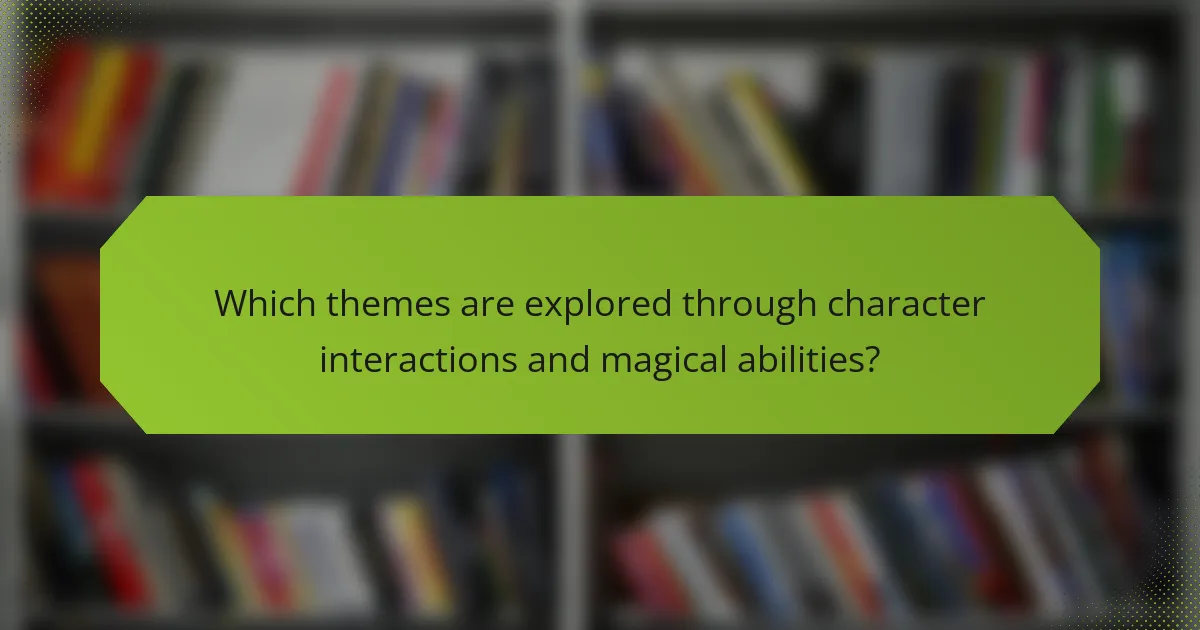
Which themes are explored through character interactions and magical abilities?
Character interactions and magical abilities in the Mistborn series explore themes of power, trust, and sacrifice. Characters navigate complex relationships, revealing how their magical skills influence their social dynamics. The interplay between Allomancy and character development highlights moral dilemmas and personal growth. As characters wield their abilities, they confront the consequences of their actions, emphasizing the theme of responsibility. This intricate web of interactions deepens the world-building and enriches the narrative.
How do themes of sacrifice and redemption manifest in character choices?
Themes of sacrifice and redemption are central to character choices in the Mistborn series. Characters often face pivotal moments where they must choose between personal gain and the greater good. For instance, Vin’s journey illustrates how her sacrifices lead to redemption not just for herself but for her world.
Kelsier embodies the theme of sacrifice as he inspires others to rise against oppression, ultimately sacrificing his life for a cause greater than himself. This act of selflessness transforms him into a symbol of hope.
Redemption manifests through characters like Elend, who evolves from a privileged noble to a leader willing to sacrifice his status for the sake of his people. His choices reflect the series’ exploration of moral complexity and the impact of personal decisions on collective fate.
Overall, the interplay of sacrifice and redemption shapes character arcs, emphasizing that choices carry profound consequences within the intricate world-building of Mistborn.
What moral dilemmas arise from the use of magic in the narrative?
The use of magic in the Mistborn series presents significant moral dilemmas, particularly concerning power, control, and the consequences of choices. Characters grapple with the ethical implications of wielding immense power, as seen with Allomancy and its potential for corruption. The series explores themes of sacrifice, loyalty, and the impact of one’s actions on society. For instance, characters must decide whether to use their abilities for personal gain or the greater good, often facing dire consequences. These moral conflicts drive character development and deepen the narrative’s complexity, illustrating the weight of responsibility that comes with power.
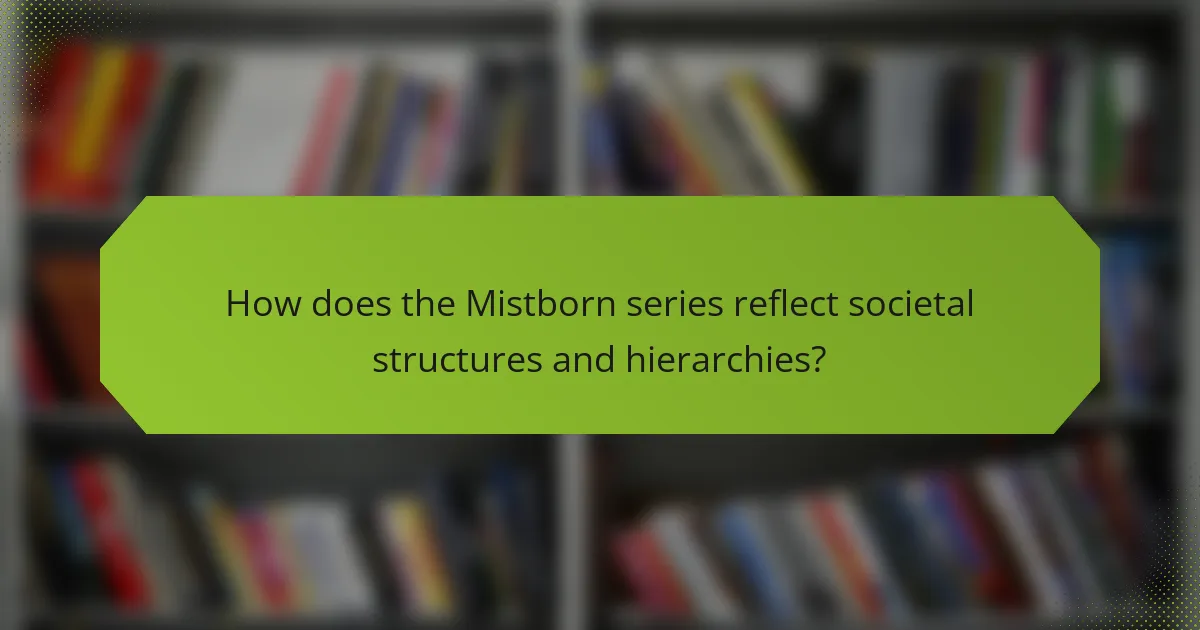
How does the Mistborn series reflect societal structures and hierarchies?
The Mistborn series illustrates societal structures and hierarchies through its class divisions and power dynamics. The world is structured around the oppression of the skaa by the nobility, reflecting real-world class struggles.
The magic system, Allomancy, further emphasizes these hierarchies, as only the nobility possess the ability to use it fully. This creates a unique attribute where power is not just physical but also magical, reinforcing social stratification.
Character development in the series showcases the journey of individuals like Vin, who rise from the lower classes to challenge the established order. This transformation highlights themes of rebellion and the quest for equality.
Ultimately, the Mistborn series serves as a commentary on societal structures, emphasizing the impact of power, privilege, and the potential for change within rigid hierarchies.
What parallels can be drawn between the series’ society and real-world issues?
The Mistborn series reflects real-world issues through its exploration of class struggle and power dynamics. The oppressive society in the series mirrors historical and contemporary social hierarchies. For instance, the nobility’s exploitation of the skaa parallels modern economic disparities. Additionally, the use of magic as a tool for control highlights how authority can manipulate resources to maintain dominance. This connection prompts readers to reflect on their societal structures and the impact of systemic inequality.
How do different characters navigate the class system in Scadrial?
Characters in the Mistborn series navigate the class system through their unique abilities and social status. Nobles wield power and influence, while skaa face oppression and limited opportunities. Vin, a skaa, rises through her allomantic skills, challenging societal norms. Elend, a noble, seeks to reform the class system, demonstrating the potential for change. The interplay of allomancy and class highlights the struggles and aspirations of each character, emphasizing the series’ themes of inequality and rebellion.
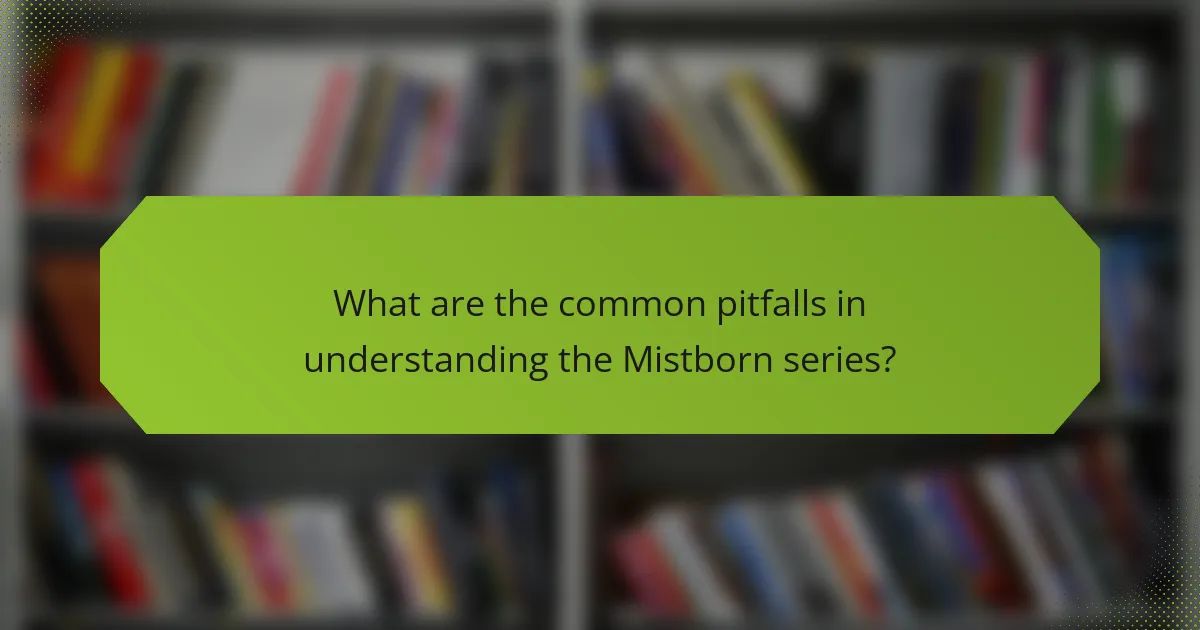
What are the common pitfalls in understanding the Mistborn series?
Common pitfalls in understanding the Mistborn series include overlooking character motivations, misinterpreting the magic system’s rules, and neglecting the depth of world-building. Readers often focus on action rather than character development, missing key emotional arcs. The intricate magic system can confuse those unfamiliar with its limitations and implications. Additionally, the rich world-building requires attention to detail, as subtle elements significantly impact the narrative’s themes and character choices.
What misconceptions do readers often have about the characters and their motivations?
Readers often misinterpret characters’ motivations in the Mistborn series, assuming they are solely driven by power or revenge. In reality, characters like Vin and Kelsier exhibit complex motivations shaped by their backgrounds and experiences. For example, Vin’s journey reflects her struggle for identity and belonging, while Kelsier’s actions stem from a desire for justice and freedom. These deeper layers often get overlooked, leading to simplistic views of their actions. Understanding these nuances enriches the reading experience and reveals the intricate world-building and character development crafted by Brandon Sanderson.
How can readers better appreciate the complexity of the magic systems?
Readers can better appreciate the complexity of magic systems in the Mistborn series by exploring their unique rules and limitations. The allomancy system features distinct metals with specific effects, creating a rich tapestry of interactions. Understanding character motivations tied to their magic use deepens the narrative experience. Additionally, the interplay between different magic systems, such as allomancy and feruchemy, reveals intricate world-building. Analyzing how these systems influence character development enhances appreciation for the series’ depth.
What strategies can enhance the reading experience of the Mistborn series?
To enhance the reading experience of the Mistborn series, focus on immersive world-building, character arcs, and intricate magic systems. Engaging with detailed character backstories deepens emotional investment. Exploring the unique societal structures and historical context enriches the world. Understanding the complex magic systems adds layers to the narrative. Reading companion materials or fan analyses can offer new insights.

